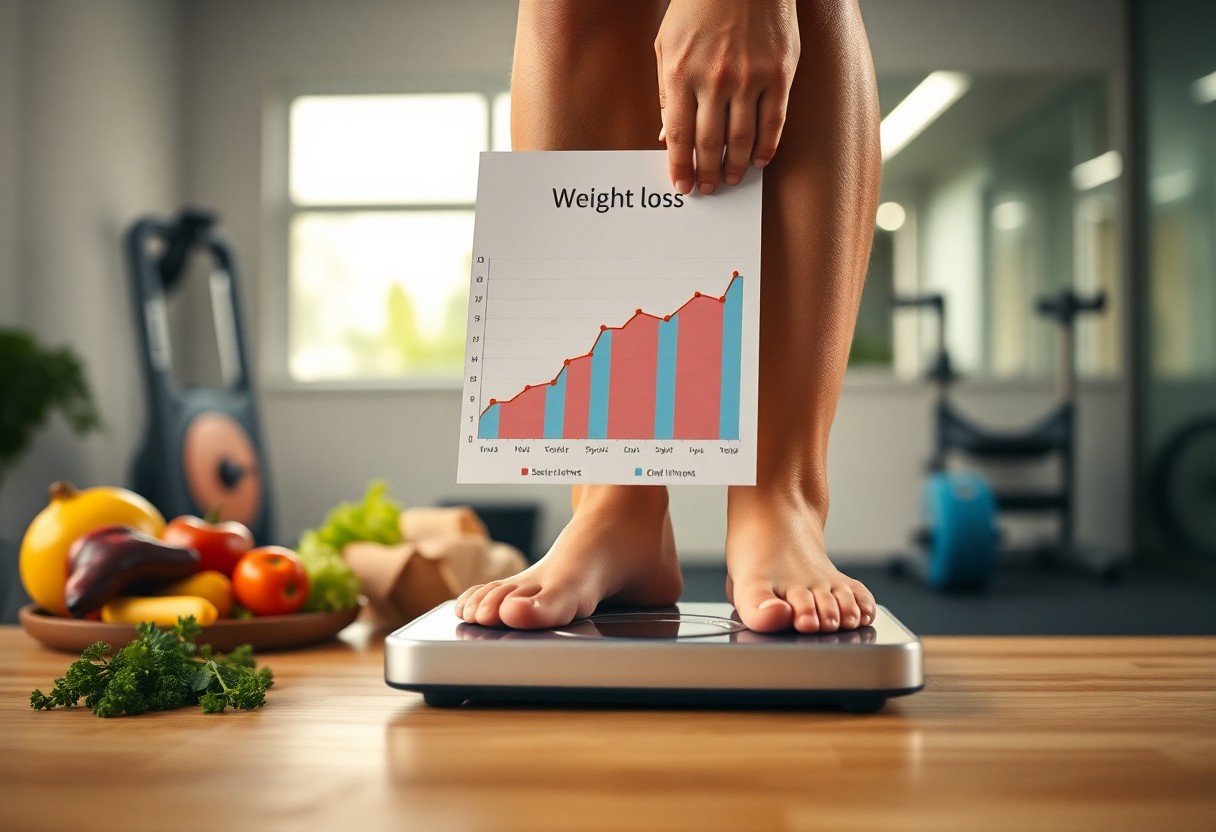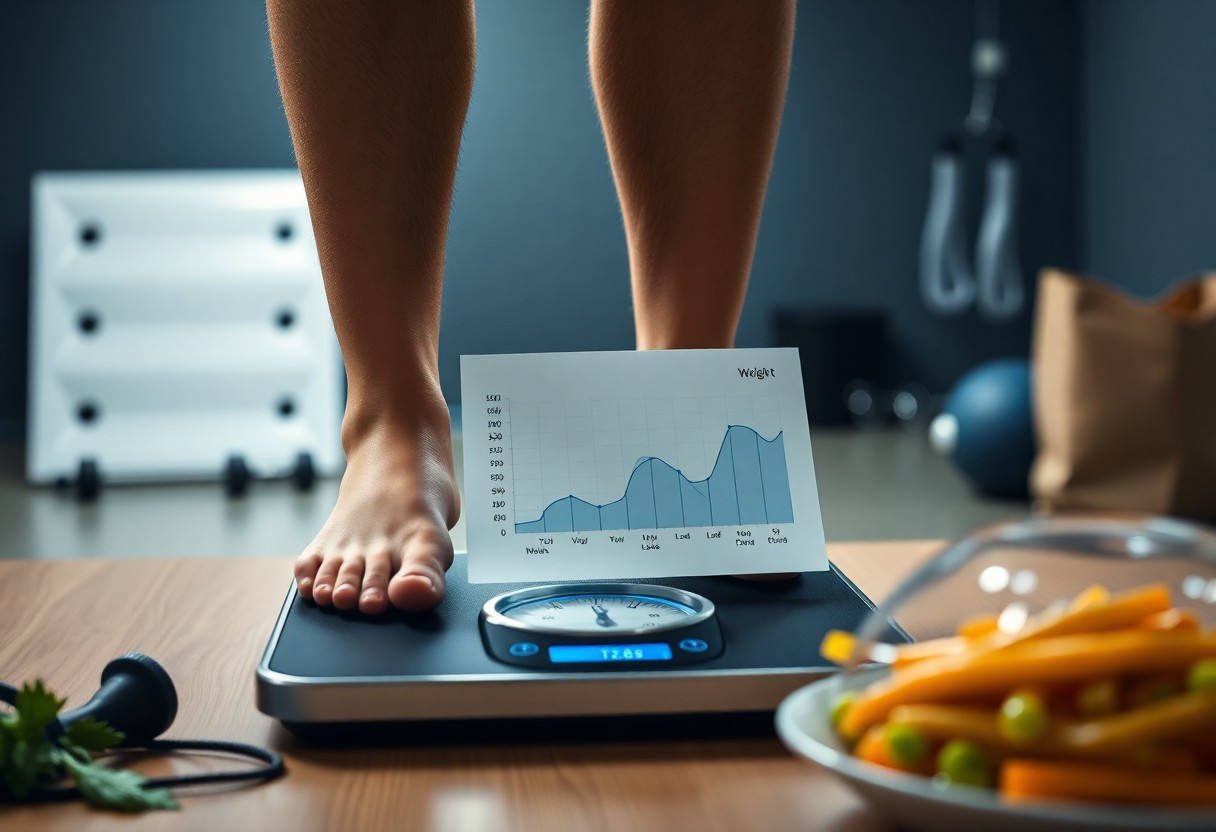Many people experience frustrating weight loss plateaus during their health journeys. This can happen when your body adjusts to your diet and exercise routine, making it hard to shed more pounds. However, understanding how to recognize these plateaus and adopting effective strategies to overcome them can help you reach your goals. In this guide, you will learn practical tips to break through those stalls and continue progressing toward a healthier you.
Key Takeaways:
- A weight loss plateau is common and often occurs after initial success. This does not mean you should give up.
- To move past a plateau, evaluate your diet and exercise routine. Small changes can help restart your progress.
- Stay patient and maintain a positive mindset. Weight loss is a journey, and persistence can lead to success.

Understanding Weight Loss Plateaus
Before you explore your weight loss journey, it’s important to understand what a weight loss plateau is and why it happens. A weight loss plateau can occur when you stop losing weight after a period of success. This can be frustrating, but recognizing this phase is key to moving forward effectively. Knowing how to handle it will keep you motivated and on the right track.
What is a Weight Loss Plateau?
Clearly, a weight loss plateau happens when your body stops shedding pounds despite your consistent efforts. You may be following the same diet and exercise routine that worked before, but the scale won’t budge. This can be discouraging, but it’s a common phase in any weight loss program.
Common Causes of Weight Loss Plateaus
Little changes in your body can lead to a weight loss plateau. These might include metabolic adjustment, decreased calorie burn, or changes in your hormonal balance. Many factors can influence your weight loss journey, and knowing them helps you adapt your plan.
Weight loss plateaus often occur after your body adjusts to new eating or exercise habits. As you lose weight, your metabolism may slow down because your body requires fewer calories to function. Additionally, if you lose muscle while dieting, your body burns fewer calories at rest. Stress and hormonal changes can also impact your weight loss, making it harder to continue shedding pounds. Understanding these causes equips you to break through the plateau and achieve your goals.
How to Identify a Weight Loss Plateau
It can be frustrating when you’re putting in the effort to lose weight but stop seeing results. A weight loss plateau occurs when your body’s weight stabilizes after a period of loss. Understanding this phase is important because it can help you identify when you need to adjust your approach. Common reasons for plateaus include muscle gain, changes in metabolism, or simply your body getting used to a routine. Knowing how to recognize these signals can empower you to make informed decisions for your health journey.
Signs You Are Experiencing a Plateau
To identify if you are facing a plateau, watch for a few key signs. First, you may notice that your weight has not changed for several weeks, despite sticking to your diet and exercise plan. You might feel less motivated or experience increased cravings. Additionally, body measurements may remain the same, and your energy levels could fluctuate more than normal. Recognizing these signs early can help you take action before frustration sets in.
Tracking Your Progress
Tracking your progress is crucial in identifying a weight loss plateau. Regularly weighing yourself, keeping a journal, or using apps can help you understand your journey better. This data allows you to notice patterns and make necessary changes to your routine. You can focus not just on your weight but also on how your clothes fit and your overall health.
For instance, you could record your weight weekly, taking note of other metrics like body measurements and energy levels. This comprehensive approach gives you a clear picture of your progress over time. If you notice minimal changes despite your efforts, it could be a sign that you’ve hit a plateau. Keeping thorough records encourages accountability and provides motivation to change up your routine when necessary.

Tips for Overcoming a Weight Loss Plateau
Now you have the tools to tackle that weight loss plateau. Consider these tips:
- Track your food intake.
- Stay hydrated.
- Try new exercises.
- Get enough sleep.
- Stay consistent and patient.
This approach will help you navigate the challenges of maintaining weight loss and keep your journey on track. For further advice on how to Overcome a Weight Loss Plateau, read more here.
Adjusting Your Diet
Little changes in your diet can make a big impact. Start by examining your portion sizes. You might need to cut back a bit. Also, try incorporating more fruits and vegetables. These foods are low in calories but high in nutrients, helping you feel full. Finally, consider reducing sugar and processed foods, as they can hinder your progress.
Reevaluating Your Exercise Routine
To break the plateau, it is important to change your exercise routine. If you’ve been doing the same workouts, your body may have adapted. Try adding new activities or increasing intensity. Consider strength training, which builds muscle and boosts metabolism. Also, introduce interval training to your cardio workouts for better fat burning.
Plateauing can be frustrating, but it’s a common part of weight loss. By mixing up your exercises and pushing yourself a bit harder, you can reignite your progress. Keep track of your workouts, and always aim for a variety of exercises. This will prevent your body from becoming too comfortable, allowing you to continue losing weight effectively.
Lifestyle Factors That Influence Weight Loss
Unlike what many people believe, weight loss isn’t just about calorie counting. Several lifestyle factors can greatly affect your journey. Here are some influential factors:
- Sleep habits
- Stress levels
- Hydration
- Nutrition
This means paying attention to these areas can help you break through a weight loss plateau.
Sleep and Stress Management
Little things, like how well you sleep and how you manage stress, can impact your weight loss. Poor sleep can lead to weight gain, while high stress may cause emotional eating. Focus on creating a relaxing bedtime routine and finding effective stress-relief methods.
Hydration and Nutrition
An effective weight loss plan also depends on hydration and nutrition. You need to drink enough water and eat a balanced diet. Water helps your body function properly, while good nutrition fuels your energy levels.
Hydration plays a key role in metabolism. When you’re well-hydrated, your body can burn calories more efficiently. Try to drink at least eight glasses of water daily. Pair this with nutrient-rich foods like fruits, vegetables, lean proteins, and whole grains. This combination will support your weight loss goals and help you feel satisfied.

Mental Strategies to Break Through Plateaus
After reaching a weight loss plateau, it’s crucial to employ mental strategies for success. A positive mindset can significantly influence your journey. Focus on what you’ve achieved rather than what’s left. Visualize your goals and celebrate small victories along the way. This approach shifts your focus from frustration to motivation, making it easier to push through barriers. Use these mental tools to keep your determination strong while working towards your goals.
Staying Motivated
Clearly, staying motivated during a weight loss plateau can be challenging. To keep your spirits high, surround yourself with supportive friends or family. Engage in activities that energize and excite you. Try new workouts or healthy recipes to keep things fresh. By finding joy in the process, you’ll be more likely to stay committed to your goals.
Setting Achievable Goals
For long-term success, setting achievable goals is vital. Break larger goals into smaller, manageable milestones. Instead of focusing only on losing a specific amount of weight, aim to exercise regularly or try cooking healthy meals several times a week. This makes your journey less daunting and encourages a sense of accomplishment.
Through these smaller goals, you can track your progress more effectively. Each time you reach a milestone, you’re likely to feel a sense of achievement that boosts your motivation. For example, if your goal is to exercise three times a week, celebrate when you hit that target. By focusing on what you can achieve today, you create a positive feedback loop that propels you forward, even during plateaus.
When to Seek Professional Help
Not every weight loss plateau requires professional help, but you should seek guidance if your progress stalls for more than a month. If you’re following a healthy diet and exercise routine without seeing results, reaching out to a specialist can provide fresh insights. Professionals can help identify underlying issues or new approaches to break through the plateau and support your weight loss journey.
Consulting a Nutritionist
Some people struggle with understanding proper nutrition and meal planning. A nutritionist can help you create a tailored diet plan suitable for your needs. They analyze your eating habits and suggest improvements. With their expertise, you can receive personalized recommendations that could lead to better results.
Speaking with a Health Coach
Any weight loss journey can benefit from the support of a health coach. They provide motivation and accountability, helping you stay on track with your goals. A health coach works with you to develop practical strategies that fit your lifestyle, making it easier to overcome obstacles.
Coach your focus on sustainable habits that allow you to regain momentum. They can offer techniques to manage stress and emotional eating, which are often roadblocks on the path to weight loss. By working together, you can set realistic goals and celebrate small successes, keeping you motivated. Your health coach will support you every step of the way, making your weight loss journey more manageable and enjoyable.
To wrap up
Conclusively, understanding and recognizing a weight loss plateau is key to overcoming it. You should assess your eating and exercise habits, consider changing your routine, and ensure you are getting enough rest. Small adjustments can make a big difference. Staying patient and focused will help you move past this hurdle. Keep your goals in mind and adapt your strategies as needed to keep your progress going. You’ve got this!
# How to Recognize and Overcome a Weight Loss Plateau
## Introduction
Experiencing a weight loss plateau is common. It can be frustrating and demotivating. You might feel like you are doing everything right, yet the scale does not budge. Understanding how to recognize a plateau and what steps to take can make the process easier. Let’s explore how to identify and overcome this challenge.
## What is a Weight Loss Plateau?
A weight loss plateau happens when your weight stays the same for several weeks, even with continued efforts in diet and exercise. It may seem like your progress has stalled, but it is a normal part of the weight loss journey.
### How to Recognize a Weight Loss Plateau
1. Stable Weight: You notice your weight remains the same for two to four weeks.
2. Consistent Efforts: You are still following your diet and exercise routine as before.
3. Zero Change in Measurements: Body measurements, like waist or hips, do not change.
4. Unchanged Energy Levels: You still feel energetic and healthy, but the scales tell a different story.
—
## Signs You Might be in a Weight Loss Plateau
– No Change in Calories Burned: Your body may adjust to your routine, leading to fewer calories burned.
– Increased Hunger or Cravings: You might notice you are hungrier, making it harder to stick to your plan.
– Fatigue: Feeling tired or unmotivated can also signify a need for change.
—
## How to Overcome a Weight Loss Plateau
Overcoming a plateau may take effort, but it is possible. Here are some effective strategies:
1. Reassess Your Caloric Intake: As you lose weight, your body needs fewer calories. Track your daily intake to adjust accordingly.
2. Change Your Exercise Routine: Mix in new workouts to challenge your body differently. This could mean trying strength training, cardio, or activities you haven’t done before.
3. Stay Hydrated: Drinking water can help control hunger and boost metabolism. Aim for at least 8 cups a day.
4. Get Enough Sleep: Sleep is vital for weight loss. Aim for 7-9 hours each night to help your body function well.
5. Reduce Stress: Stress can lead to emotional eating and weight gain. Try stress-reduction techniques like yoga, meditation, or deep breathing.
—
## FAQ
Q: How long does a weight loss plateau usually last?
A: A weight loss plateau can last anywhere from two weeks to several months. Don’t be discouraged! Make adjustments to your plan and stay committed.
Q: Is it normal to experience a weight loss plateau?
A: Yes, it is completely normal. Many people encounter plateaus during their weight loss journey. It’s a sign that your body is adjusting.
Q: Should I change my diet during a plateau?
A: Yes, consider reassessing your portions and food choices. Sometimes, simply tracking what you eat improves awareness and helps kick-start weight loss.
Q: Can exercise help me overcome a weight loss plateau?
A: Absolutely! Adding new exercises or increasing intensity can help you break through a plateau. A mix of cardio and strength training is often effective.
Q: How can I stay motivated during a weight loss plateau?
A: Set new goals, track small victories, or join a group for support. Remember that plateaus are temporary, and staying motivated is key.
—
## Key Takeaways
– Recognize the Signs: A plateau is when your weight stays the same despite efforts.
– Reassess Your Approaches: Make changes to your diet and exercise routine.
– Stay Patient and Committed: Plateaus are a normal part of weight loss. Keep pushing forward.
By understanding how to recognize and overcome a weight loss plateau, you can stay on the path to achieving your goals. Adjust your plan, stay positive, and keep moving forward!




